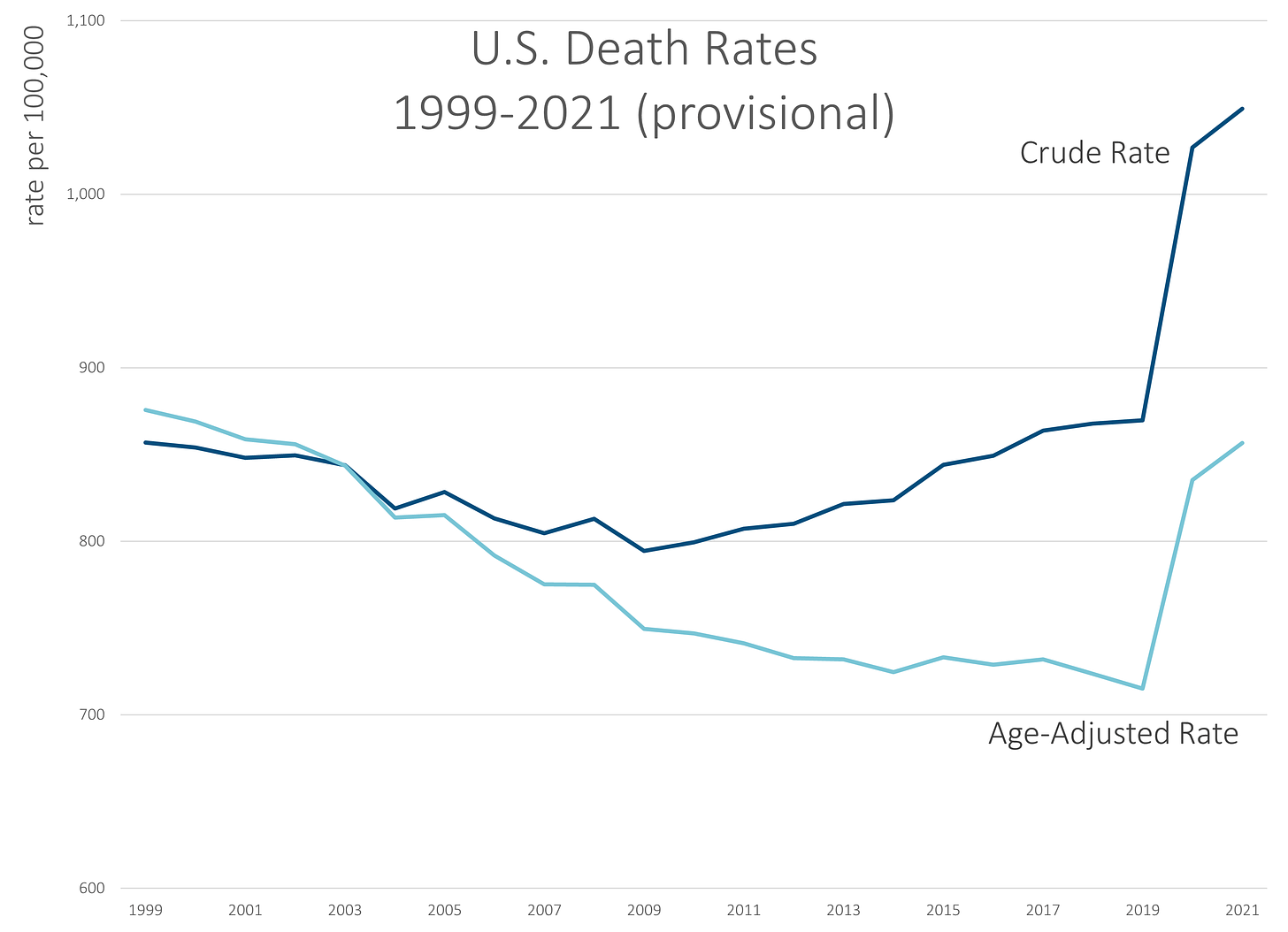2021 U.S. Mortality News Explainer: Life Expectancy, Death Rates, and More
Become an instant mortality expert!
It seems the news is catching up with me. Hello, News!
From AP News yesterday: COVID-19, overdoses pushed US to highest death total ever
2021 was the deadliest year in U.S. history, and new data and research are offering more insights into how it got that bad.
The main reason for the increase in deaths? COVID-19, said Robert Anderson, who oversees the Centers for Disease Control and Prevention’s work on death statistics.
The agency this month quietly updated its provisional death tally. It showed there were 3.465 million deaths last year, or about 80,000 more than 2020′s record-setting total.
I’m going to get extremely bitchy for a moment because 2021 wasn’t the “deadliest” year in U.S. history by any reasonable metric.
The U.S. has a population of just over 330 million people. If we had the population of China or India, having 3.5 million people die would be no great shakes. If we had the population of Canada, which is about 37 million people, 3.5 million people dying would be horrendous. It’s all relative.
So just the absolute number of people dying says nothing about how “deadly” the year was.
The Spanish Flu was much deadlier as a disease than COVID has been, even though far more people in terms of numbers have died of COVID.
The U.S. population back in 1918 was less than a third of what we have now. An estimated 500K Americans died in the Spanish Flu pandemic, so numerically fewer, but proportionately more… and given the age distribution differences, it was far worse back then.
So let me give you some explainers, and we can look at how nasty 2021 was — it was worse than 2020, and it has been worse than recent history. It’s just not the deadliest ever.
Death Rates: Crude and Age-Adjusted
The problem is collapsing the “deadliness” into a single metric. I’ll get to life expectancy in a moment, but let’s start with death rates.
I’ve written about this before:
Here’s the simple definition and explanation:
Crude death rate = the number of deaths divided by the size of the population
Age-adjusted death rate = weighted average of death rates by age groupings, where weights are standardized
The current standard weights are based on the year 2000 estimated U.S. population (it’s not the exact U.S. 2000 population, otherwise the crude rate and the age-adjusted rate for 2000 would match — but they’re close.)
Here’s a graph for 1999 through the provisional 2021 result (as of 3 April 2022 data from CDC WONDER):
You can see the crude rate is higher than the age-adjusted rate for most of the years, and that’s due to the aging of the population. Basically, the Boomers have been getting older, and their older ages (and higher mortality compared to where they were in 2000), have an effect on how many deaths there are overall — thus the crude rate continually increasing as there are more and more old people.
However, until the pandemic hit, the age-adjusted death rate in general decreased, though we had a few years in the 2010s in which the age-adjusted death rate did increase… and yes, that was due to drug overdoses. We will get to that in a bit.
In any case, both the crude rate and age-adjusted rates did jump up by a lot in 2020 due to the pandemic, and COVID deaths were even higher in 2021. But there were other causes of death also keeping mortality rates high in 2021.
I will point out that even with all this extra mortality, the age-adjusted death rate in 2021 is still below where it was in 1999.
That does not mean things are hunky-dory.
This is one of the dangers of collapsing death rates into a single number. The increase in death rates has differed by age group, and it has been far worse for teens and young adults through even young middle-age than it has been for the oldest adults.
Yes, COVID has killed the oldest adults the most, but their death rates have increased the least. It’s all relative.
Another mortality metric: Life expectancy
While age-adjusted death rate is the metric that should be used if you want to collapse mortality experience into a single number, the mortality metric most often quoted in the news is life expectancy.
From the AP News story:
With rare exceptions, U.S. life expectancy has reliably inched up year after year. But the CDC’s life expectancy estimate for 2020 was about 77 years — more than a year and a half lower than what it was in 2019.
The CDC has not yet reported its calculation for 2021. But Goldman and some other researchers have been making their own estimates, presented in papers that have not yet been published in peer-reviewed journals.
Those researchers think U.S. life expectancy dropped another five or six months in 2021 — putting it back to where it was 20 years ago.
A loss of more than two years of life expectancy over the last two years “is mammoth,” Goldman said.
I’ve written about this several times, so let me pick this post for the explainer (if you want deep detail): Mortality with Meep: Cohort vs. Period Mortality Tables
If you don’t want deep detail, here’s the nutshell:
The life expectancy you hear mentioned in the news is a shorthand for supposing mortality experience from birth to death is just like last year’s, and you calculate life expectancy based on that.
It’s completely artificial, and that life expectancy is meaningless to you as an individual.
By meaningless, I mean that you can’t use that piece of information to do retirement planning or life insurance planning or anything like that. It can be completely misleading.
If I hear that the life expectancy in 2021 dropped 1 year because teenage deaths increased 30%, does that mean I should plan for one less year in retirement? I didn’t die as a teenager last year. I’m almost 50 years old – what happened with young adult mortality last year has no effect on my retirement planning (it may make me warn my kids to be wary of drugs; fentanyl kills and you don’t know who is lacing what w/ fentanyl, mkay?)
So if you realize they’re just trying to capture general population mortality, and comparing mortality between years, then it’s okay to talk about this life expectancy (the technical term is period life expectancy, to contrast against cohort life expectancy, which is the kind you want to use, starting from the age you are now….but that’s for another time.)
The More: Primer Links
I’ve been picking up more readers the last few weeks (howdy!), and I will be doing more mortality posts, of course. I have lots of cause-of-death posts to come, because that’s really where the action is. I do need to do more COVID death analysis, but I generally don’t spend as much time on that since so many people look at that.
That said, I’ve been writing about mortality trends, especially from a basic concepts level, for years, even before I did a substack migration. Some of the links below are to my old blog site, and some are to the substack — it’s all the same meep goodness.
So for an Easter bouquet, here are some Mortality with Meep Basics so you can look at some of the concepts and trends, to get a grounding. A lot of people try to be “instant expert” online, and hey — I’m here to help! I’m an actual expert, and I don’t mind sharing the knowledge. Mortality is important to understand.
YouTube playlists
Mortality with Meep playlist — my videos going over mortality trends
One video:
Working with WONDER — my tutorials on working with the CDC database of death statistics (yes, I need to do more of these)
One video:
Mortality basics
Some of these I linked above, but let me link them again:
Mortality Basics with Meep: Age-Adjusted Death Rates v. Crude Death Rates for U.S. 1968-2020
Geeking Out: On Life Expectancy and Conditional Expectation
Mortality with Meep: Cohort vs. Period Mortality Tables
Numbers have meaning — know what is meaningful
Two pieces I wrote in 2021, with respect to the 2020 mortality results we were looking at, and as the fall delta wave came through.
June 2021: U.S. Life Expectancy Fell 2.4% in 2020, and Death Rates Increased 16.1%
In that piece, I showed what happened with period life expectancy (the type quoted in the media) for females through the Spanish flu pandemic (which lasted only one year):
Now, COVID has lasted longer than one year, and it may continue to have effects. Given that we’re seeing waves come through Europe and China again, it may be one of those diseases, like the flu, that’s just endemic, and we’ll just have to figure out how to deal with always having it around. Perhaps the mortality hit will be variable (again, similar to the flu), perhaps it will diminish. I’m not claiming to know.
But my main point was how large an effect on period life expectancy a pandemic could have, especially if it disproportionately killed young adults (which Spanish flu did). When it stopped killing, btw, the period life expectancy went right back to the trend it had before.
The main point is period life expectancy is a snapshot, and does not help you determine any long-term trend if what you have is an acute effect.
Know what it means when you see that the life expectancy changed — it can change back just as drastically if what changed it goes away as rapidly.
September 2021: Spanish flu v. COVID-19: Comparing the Numbers and Forgetting the Lessons
There were a few things in here, but it was mainly me getting pissed off at media people for one of those “grim milestones”, that grim milestone being 675K COVID deaths.
Above I said about 500K Spanish flu deaths in the U.S., which is what I’ve always seen, and here they’re claiming 675K. To me, those numbers are about the same, to the same order of magnitude. Given the error bars on measurement of things back in 1918, I say sure. It’s the same.
Well, as I tweeted at the time:

Just as it’s not really that meaningful that we have a record total number of deaths in the U.S. — that would have happened without the pandemic just due to the growth and aging of the population. Actuaries have been projecting growing numbers of deaths for decades.
As we have this huge generation that has become senior now, we have been expecting them to die. It would not have been framed as the “deadliest year” as these old people died as expected.
My main message is to try to keep a proper perspective on all these numbers you see being reported. Some are being reported in a meaningful way, and some are not being given proper context.
Yes, 2021 mortality was bad, and it was definitely worse than 2020 and recent years.
I will be demonstrating just how bad it was for various groups. For some groups, the relative increase in mortality merely takes their mortality levels back to mid-2000s, while for other groups, it’s equivalent to sending their mortality levels back decades. It’s generally related to whether it was primarily COVID driving their mortality increases (the oldest ages — 85+), or other causes (such as teens).
Please share this post with others who would like to be instant mortality experts.
Enjoy!









